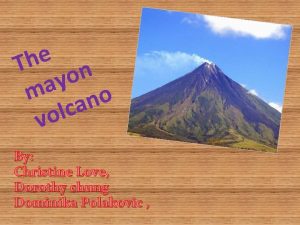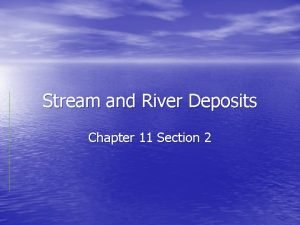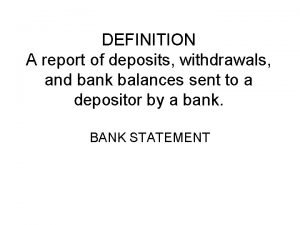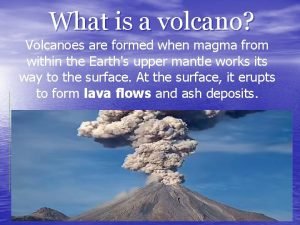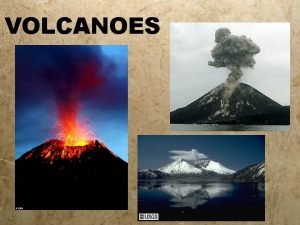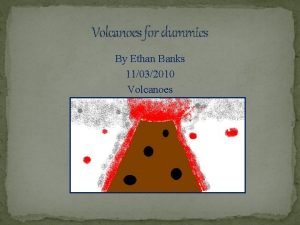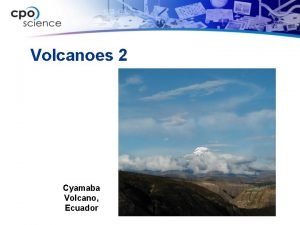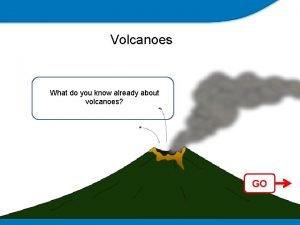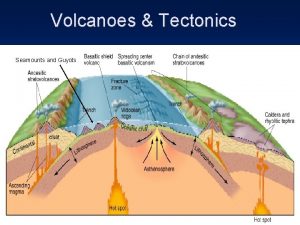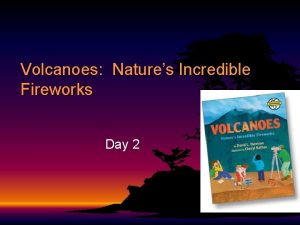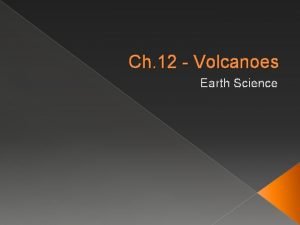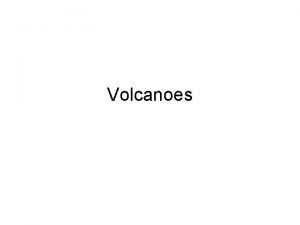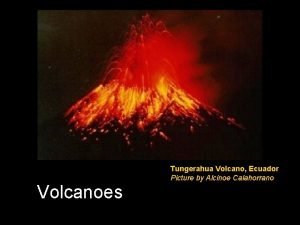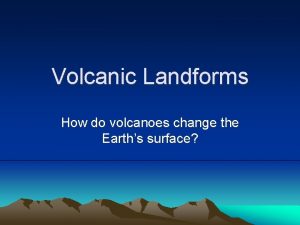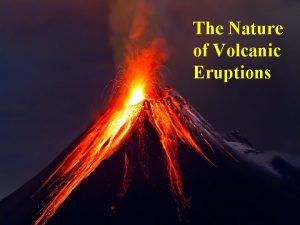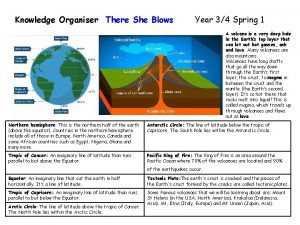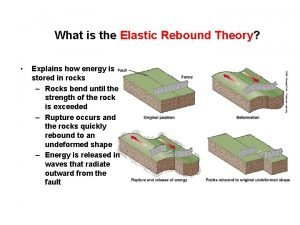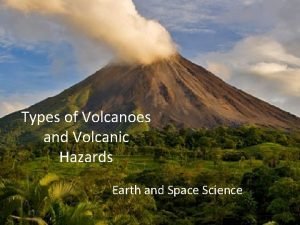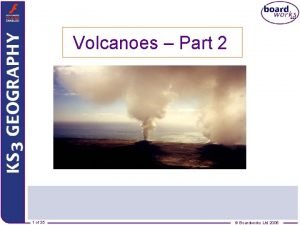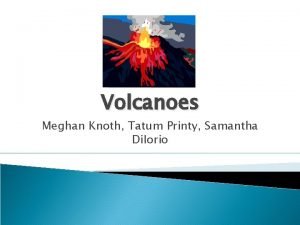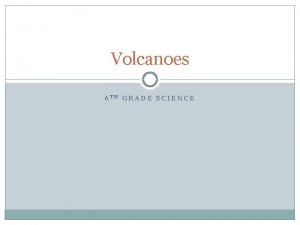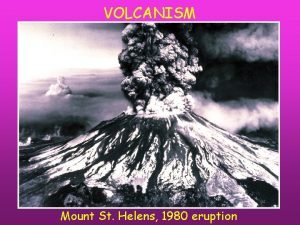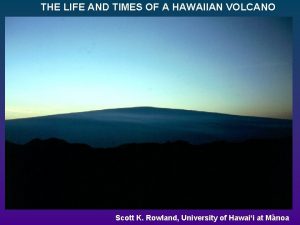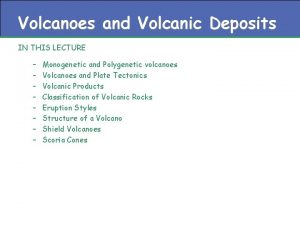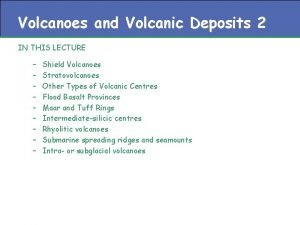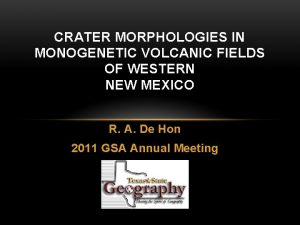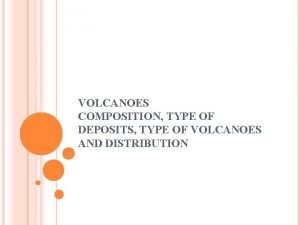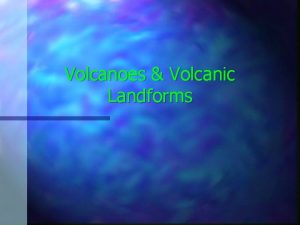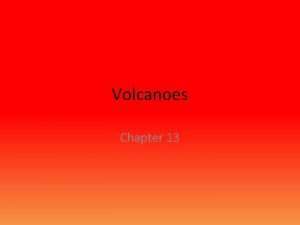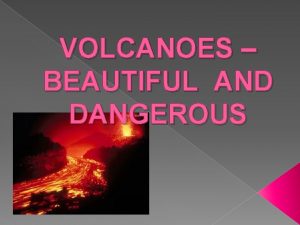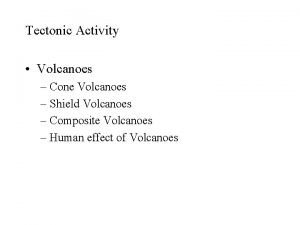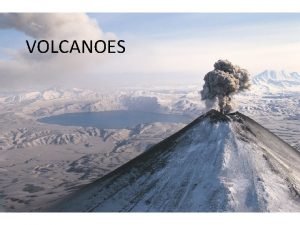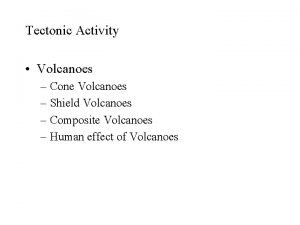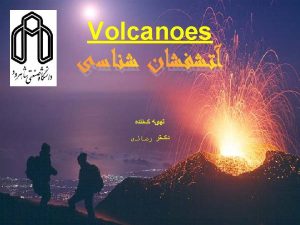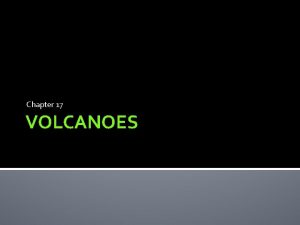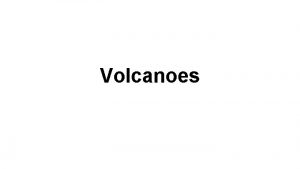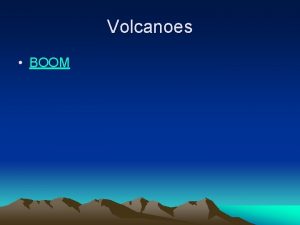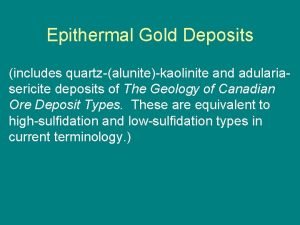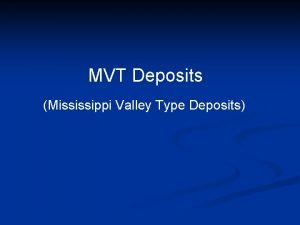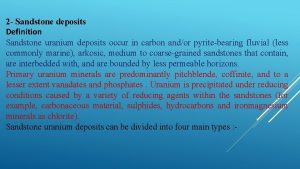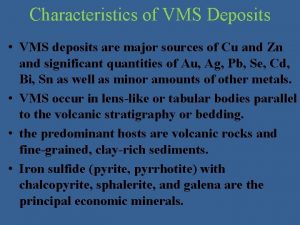Volcanoes and Volcanic Deposits IN THIS LECTURE Monogenetic





























- Slides: 29

Volcanoes and Volcanic Deposits IN THIS LECTURE – – – Monogenetic and Polygenetic volcanoes Shield Volcanoes Flood Basalts Scoria Cones Maars and Tuff Cones and Rings

Monogenetic versus polygenetic • Volcanoes can be subdivided into two types – Monogenetic • volcano built up by the products of one eruption or eruptive phase • Simple magma conduit system used during only one eruption or one prolonged eruptive phase • Example – Surtsey and Heimey – Polygenetic • volcano resulting from many eruptions, separated by relatively long periods and often involving different magmas. • Complex “plumbing systems” with intricate complicated conduit systems used many times during different eruptive phases. • Example – Hawaii

Volcanoes and Plate Tectonics

Characteristics of Volcanic rocks

Products of Volcanic Eruptions • • Tephra - a general term for fragments of volcanic rock and lava regardless of size that are blasted into the air by explosions or carried upward by hot gases in eruption columns or lava fountains. Tephra includes large dense blocks and bombs, and small light rock debris such as scoria, pumice, reticulite, and ash. As tephra falls to the ground with increasing distance from a volcano, the average size of the individual rock particles becomes smaller and thickness of the resulting deposit becomes thinner. Small tephra stays aloft in the eruption cloud for longer periods of time, which allows wind to blow tiny particles farther from an erupting volcano. Pumice is a light, porous volcanic rock that forms during explosive eruptions. It resembles a sponge because it consists of a network of gas bubbles frozen amidst fragile volcanic glass and minerals. All types of magma (basalt, andesite, dacite, and rhyolite) will form pumice. Pumice is similar to the liquid foam generated when a bottle of pressurized soda is opened--the opening depressurizes the soda and enables dissolved carbon dioxide gas to escape or erupt through the opening. During an explosive eruption, volcanic gases dissolved in the liquid portion of magma also expand rapidly to create a foam or froth; in the case of pumice, the liquid part of the froth quickly solidifies to glass around the glass bubbles.

Products of Volcanic Eruptions • Scoria is a vesicular (bubbly) glassy lava rock of basaltic to andesitic composition ejected from a vent during explosive eruption. The bubbly nature of scoria is due to the escape of volcanic gases during eruption. Scoria is typically dark gray to black in color, mostly due to its high iron content. The surface of some scoria may have a blue iridescent color; oxidation may lead to a deep reddish-brown color. • Tuff is the general name for consolidated ash. The material forming a tuff may be composed of (a) crystals ejected from the volcano; (b) small fragments (<4 mm) of lava or other rock types; (c) lapilli and (d) fragments of a glassy nature. Tuffs often show sedimentary features such as bedding and grading • Ignimbrites are welded tuffs that form when the layers of tuff material were so hot when they were deposited that the edges of the fragments weld together. Often ignimbrites display well-developed banding resulting from flattening of glass shards and other fragments and can often be mistaken for rhyolitic lavas.

Products of Volcanic Eruptions Volcanic ash - consists of rock, mineral, and volcanic glass fragments smaller than 2 mm (0. 1 inch) in diameter, which is slightly larger than the size of a pinhead. Volcanic ash is not the same as the soft fluffy ash that results from burning wood, leaves, or paper. It is hard, does not dissolve in water, and can be extremely small-ash particles less than 0. 025 mm (1/1, 000 th of an inch) in diameter are common. Ash is extremely abrasive, similar to finely crushed window glass, mildly corrosive, and electrically conductive, especially when wet. Lapilli - Rock fragments between 2 and 64 mm (0. 08 -2. 5 in) in diameter that were ejected from a volcano during an explosive eruption are called lapilli. Lapilli (singular: lapillus) means "little stones" in Italian. Lapilli may consist of many different types of tephra, including scoria, pumice, and reticulite. Accretionary Lapilli - Rounded tephra balls between 2 and 64 mm in diameter are called accretionary lapilli if they consist of tiny ash particles. Volcanic ash sometimes form such balls in an eruption column or cloud, owing to moisture or electrostatic forces. Lapilli (singular: lapillus) means "little stones" in Italian.

Products of Volcanic Eruptions • A volcanic block is a solid rock fragment greater than 64 mm in diameter that was ejected from a volcano during an explosive eruption. Blocks commonly consist of solidified pieces of old lava flows that were part of a volcano's cone. • Volcanic bombs are lava fragments that were ejected while viscous (partially molten) and larger than 64 mm in diameter. Many acquire rounded aerodynamic shapes during their travel through the air. Volcanic bombs include breadcrust bombs, ribbon bombs, spindle bombs (with twisted ends), spheroidal bombs, and "cow-dung" bombs. Selection of Volcanic bombs

Classification of Volcanic Products Lavas Pyroclastic Rocks

New Terms Calderas and Craters A caldera is a large, usually circular depression at the summit of a volcano formed when magma is withdrawn or erupted from a shallow underground magma reservoir. The removal of large volumes of magma may result in loss of structural support for the overlying rock, thereby leading to collapse of the ground and formation of a large depression. Calderas are different from craters, which are smaller, circular depressions created primarily by explosive excavation of rock during eruptions. Aniakchak Caldera formed during an enormous explosive eruption that expelled more than 50 km 3 of magma about 3, 450 years ago. The caldera is 10 km in diameter and 500 -1, 000 m deep. Subsequent eruptions formed domes, cinder cones, and explosion pits on the caldera floor.

‘A’a and pahoehoe lavas A`a (pronounced "ah-ah") is a Hawaiian term for lava flows that have a rough rubbly surface composed of broken lava blocks called clinkers. The incredibly spiny surface of a solidified `a`a flow makes walking very difficult and slow. The clinkery surface actually covers a massive dense core, which is the most active part of the flow. As pasty lava in the core travels downslope, the clinkers are carried along at the surface. At the leading edge of an `a`a flow, however, these cooled fragments tumble down the steep front and are buried by the advancing flow. This produces a layer of lava fragments both at the bottom and top of an `a`a flow. Pahoehoe is a Hawaiian term for basaltic lava that has a smooth, hummocky, or ropy surface. A pahoehoe flow typically advances as a series of small lobes and toes that continually break out from a cooled crust. The surface texture of pahoehoe flows varies widely.

Pyroclastic Flows A pyroclastic flow is a ground-hugging avalanche of hot ash, pumice, rock fragments, and volcanic gas that rushes down the side of a volcano as fast as 100 km/hour or more. The temperature within a pyroclastic flow may be greater than 500° C, sufficient to burn and carbonize wood. Once deposited, the ash, pumice, and rock fragments may deform (flatten) and weld together because of the intense heat and the weight of the overlying material. Pyroclastic flow sweeps down the side of Mayon Volcano, Philippines, during an explosive eruption on 15 September 1984. Note the ground-hugging cloud of ash (lower left) that is billowing from the pyroclastic flow and the eruption column rising from the top of the volcano. Maximum height of the eruption column was 15 km above sea level, and volcanic ash fell within about 50 km toward the west. There were no casualties from the 1984 eruption because more than 73, 000 people evacuated the danger zones as recommended by scientists of the Philippine Institute of Volcanology and Seismology.

Effects of Pyroclastic Flows • View north from the summit of Mount St. Helens shows the pristine forest that surrounded Spirit Lake (lower right) at the base of the volcano before the 1980 eruption. • View north from above the crater of Mount St. Helens after the 18 May 1980 eruption at about the same elevation as the former summit. The gray, ash-covered area surrounding Spirit Lake is the former forest that was destroyed by the eruption's enormous pyroclastic surge, commonly known as the directed blast or lateral blast. Note the increased surface area of Spirit Lake compared to the preeruption photograph. The lake's elevation was raised by about 60 m to 1038 m when part of the eruption's landslide swept into the lake (the landslide began about 20 seconds before the pyroclastic surge). Most of the lake's surface is covered with tree trunks swept into the lake by the surge.

Plinian Eruptions Plinian eruptions are large explosive events that form enormous dark columns of tephra and gas high into the stratosphere (>11 km). Such eruptions are named for Pliny the Younger, who carefully described the disastrous eruption of Vesuvius in 79 A. D. This eruption generated a huge column of tephra into the sky, pyroclastic flows and surges, and extensive ash fall. Many thousands of people evacuated areas around the volcano, but about 2, 000 were killed, including Pliny the Older. Plinian Eruption Mt Pinatubo, Philippines June 15, 1991 Some plinian eruptions inject such large quantities of aerosols (small liquid droplets) into the stratosphere that surface temperatures on earth may decrease slightly. The eruption of Mount Pinatubo, Philippines, and the 1982 eruption of El Chichón, Mexico caused temperatures worldwide to decrease slightly. The massive 1815 eruption of Mount Tambora volcano, Indonesia, is thought to have caused the 1816 "Year without a Summer" in the northeastern U. S. , Canada, and western Europe.

Phreatic Eruptions Phreatic eruptions are steam-driven explosions that occur when water beneath the ground or on the surface is heated by magma, lava, hot rocks, or new volcanic deposits (for example, tephra and pyroclastic-flow deposits). The intense heat of such material (as high as 1, 170° C for basaltic lava) may cause water to boil and flash to steam, thereby generating an explosion of steam, water, ash, blocks, and bombs. Phreatic eruption at the summit of Mount St. Helens, Washington. Hundreds of these steam-driven explosive eruptions occurred as magma steadily rose into the cone and boiled groundwater. These phreatic eruptions preceded the volcano's plinian eruption on 18 May 1980.

Strombolian Eruptions Strombolian eruptions are characterized by the intermittent explosion or fountaining of basaltic lava from a single vent or crater. Each episode is caused by the release of volcanic gases, and they typically occur every few minutes or so, sometimes rhythmically and sometimes irregularly. The lava fragments generally consist of partially molten volcanic bombs that become rounded as they fly through the air. The word strombolian is derived from the volcano Stromboli, one of the Aeolian Islands north of Sicily. Stromboli has been almost continuously in eruption for at least the past 2, 400 years. Other volcanoes that often exhibit strombolian activity include Etna (Italy), Pacaya (Guatemala), and Erebus (Antarctica).

Vulcanian Eruptions A vulcanian eruption is a type of explosive eruption that ejects new lava fragments that do not take on a rounded shape during their flight through the air. This may be because the lava is too viscous or already solidified. These moderate -sized explosive eruptions commonly eject a large proportion of volcanic ash and also breadcrust bombs and blocks. Andesitic and dacitic magmas are most often associated with vulcanian eruptions, because their high viscosity (resistance to flow) makes it difficult for the dissolved volcanic gases to escape except under extreme pressure, which leads to explosive behavior. Eruption column caused by a vulcaniantype explosive eruption on Oct 5 1998, rises above Tavurvur Volcano in Rabaul Caldera, Papua New Guinea.

Characterising Different Eruption Types

Structure of a Volcano Generic Structure of a Volcano • A volcanic vent is an opening exposed on the earth's surface where volcanic material is emitted. • All volcanoes contain a central vent underlying the summit crater of the volcano. • The volcano's cone-shaped structure, or edifice, is built by the more-or-less symmetrical accumulation of lava and/or pyroclastic material around this central vent system. • The central vent is connected at depth to a magma chamber, which is the main storage area for the eruptive material. • Because volcano flanks are inherently unstable, they often contain fractures that descend downward toward the central vent, or toward a shallow-level magma chamber. • Such fractures may occasionally tap the magma source and act as conduits for flank eruptions along the sides of the volcanic edifice. • These eruptions can generate cone-shaped accumulations of volcanic material, called parasitic cones. • Fractures can also act as conduits for escaping volcanic gases, which are released at the surface through vent openings called fumaroles.

Main Volcano Types Although every volcano has a unique eruptive history, most can be grouped into three main types based largely on their eruptive patterns and their general forms. The form and composition of the three main volcano types can be summarized as follows.

Scoria Cones (or Cinder Cones) • • • Most common type of volcanic centre. Small volcanic landforms built typically during subaerial strombolian eruptions of basaltic andesite magmas Usually circular in plan view owing to formation from a point source Elongate forms develop when eruptions continue along a large part of a fissure which does not localise to a single point source vent Usually have central bowl shaped craters Basal diameter is up to 2. 5 km and slopes of around 33° Many layers in scoria cones are made up of scoria or cinder as well as mass-flow deposits related to avalanching of material down the steep slopes but can also include bombs of lava spatter Often scoria cones have accompanying lava flows of fairly small volumes Gas content of the magma associated with scoria cones increases towards the end of the eruption and so the lava spatter ejected normally increases leaving a collar of material on the cone. Eruptions range in duration from a few days to a few years with 95 % of scoria cone eruptions stopping within one year. Scoria cones are very susceptible to weathering

Scoria Cones This scoria cone on the flank of Mount Etna is surrounded by a younger basaltic lava flow. This scoria cone (Pu`u ka Pele) was erupted low on the southeast flank of Mauna Kea Volcano. The cone is 95 m in height, and the diameter of the crater at the top is 400 m. Hualalai Volcano in background.

Scoria Cones – Additional Info • Scoria cones usually erupt lava flows, either through a breach on one side of the crater or from a vent located on a flank. Lava rarely issues from the top (except as a fountain) because the loose, non cemented cinders are too weak to support the pressure exerted by molten rock as it rises toward the surface through the central vent. • Perhaps the most famous scoria cone, Paricutin, grew out of a corn field in Mexico in 1943 from a new vent. Eruptions continued for 9 years, built the cone to a height of 424 meters, and produced lava flows that covered 25 km 2. • Scoria cones are commonly found on the flanks of shield volcanoes, stratovolcanoes, and calderas. For example, geologists have identified nearly 100 scoria cones on the flanks of Mauna Kea, a shield volcano located on the Island of Hawai`i. • The Earth's most historically active scoria cone is Cerro Negro in Nicaragua. It is part of a group of four young cinder cones NW of Las Pilas volcano. Since it was born in 1850, it has erupted more than 20 times, most recently in 1992 and 1995.

Shield Volcanoes - Intro • Basic characteristics of shield volcanoes – Symmetrical and circular to elliptical in shape – Convex-up piles of basaltic lava with slopes < 10° – Built up by fluidal eruptions of basaltic lavas from central vents and/or flank eruptions – Shield basal diameter (Ws) varies between a few kilometers to over 100 kms – Shield heights (Hs) are on average 1/20 Ws – Composed almost entirely of lava flows but also may contain • < 1% pyroclastic deposits including scoria fall • Deposits from phreatomagmatic and phreatic explosions • Some oxidised soil horizons and epiclastic sediments – Divided into two types • Large or Hawaiian Shields • Small or Icelandic Shields

Shield Volcanoes - Hawaiian • Hawaiian Shield Volcanoes – Summit calderas and major rift zones marked by spatter cones, spatter ramparts, collapse craters (pit craters), scoria cones and smaller superimposed monogenetic shields – Shape usually controlled by eruptions from the rift zones – Eruptions within the calderas occur slightly more frequently than on the rifts but the eruptions from the lateral rifts that give the shields their elongate form. – Calderas range from 5 to 20 kms in diameter – Shields are built by lavas and minor pyroclastics as well as high level intrusives which may be present in the summit caldera walls. – Compositional differences occur as the shield volcano evolves changing from tholeiitic to progressively more alkalic – More explosive activity accompanies the eruptions of alkaline magmas. – Eruption frequency decreases with time

Hawaiian Volcanic Chain • • • The two most active shields on Hawaii are Kilauea and Mauna Loa is the world’s largest active volcano – Rises nearly 9 km from the pacific ocean floor to its summit of 4169 m above sea level – Total volume of 40, 000 km 3 Combined growth rate of ~0. 1 km 3 per year indicates both Kilauea and Mauna Loa could have been built in less than 1 Ma Large portion of the base of both volcanoes made up of pillow lava formed by subaqueous extrusions Gravity sliding and slumping along normal faults is common on the flanks and occurs in response to oversteepening caused by addition of lava flows and intrusion of magma into the summit.

Mauna Loa Snow-covered Moku`aweoweo Caldera atop Mauna Loa shield volcano (Mauna Kea in background). The caldera is 3 x 5 km across, 183 m deep, and is estimated to have collapsed between 600 -750 years ago. Several pit craters along the upper southwest rift zone of Mauna Loa (lower right) also formed by collapse of the ground. For more information on the world’s largest volcano visit http: //hvo. wr. usgs. gov/maunaloa/

Shield Volcanoes - Icelandic • Icelandic shield volcanoes – Smaller – Ws < 15 km – Symmetrical – Almost entirely built up by effusive eruptions from a central summit vent – Summit crators usually < 1 km across and often have raised rims of spatter – Few radial fissures or lines of parasitic cones – Generally composed of large numbers of thin pahoehoe flows – Mostly monogenetic and usually constructed in less than 10 years.

Shield Volcanoes - Galapagos • • There is a third type of shield volcano known as the Galapagos type. Very similar to Hawaiian shield volcanoes but the shape of the upper summit is different Gentle lower slopes that rise to steeper central slopes that flatten off around spectacular summit calderas. Usually more alkaline than Hawaiian volcanoes Three-deminsional Space Shuttle Image of the Alcedo Shield Volcano, Galapagos -- The near circular caldera of the Alcedo shield volcano on the big island of Isabela is a feature common to many of the Galapagos shield volcanoes. The image, taken by the Space Shuttle Endeavor, covers an area of about 75 km by 60 km. The oblique view was constructed by overlaying a Spaceborne Radar Image on a digital elevation map. The vertical scale is exaggerated by a factor of 1. 87.
 01:640:244 lecture notes - lecture 15: plat, idah, farad
01:640:244 lecture notes - lecture 15: plat, idah, farad Chapter 8 earthquakes and volcanoes
Chapter 8 earthquakes and volcanoes Differentiate active and inactive volcanoes
Differentiate active and inactive volcanoes Erosion is a destructive force that
Erosion is a destructive force that Chapter 11 section 2 stream and river deposits answer key
Chapter 11 section 2 stream and river deposits answer key An endorsement indicating a new owner of a check.
An endorsement indicating a new owner of a check. How volcanoes are formed
How volcanoes are formed How are volcanoes classified
How are volcanoes classified Volcanoes for dummies
Volcanoes for dummies Ecuador
Ecuador How are volcanoes made
How are volcanoes made What do you already know about volcanoes?
What do you already know about volcanoes? Three main ways volcanoes are created
Three main ways volcanoes are created Volcanoes nature's incredible fireworks
Volcanoes nature's incredible fireworks Explain the theory of plate tectonics.
Explain the theory of plate tectonics. How are volcanoes formed
How are volcanoes formed Most volcanoes occur __________. *
Most volcanoes occur __________. * Active volcanoes map
Active volcanoes map How do volcanoes change landforms?
How do volcanoes change landforms? Shield volcano
Shield volcano Volcanoes knowledge organiser
Volcanoes knowledge organiser The elastic rebound theory explains how
The elastic rebound theory explains how Types of volcanoes
Types of volcanoes Ring of fire volcanoes
Ring of fire volcanoes Magma chamber
Magma chamber Lava and magma difference
Lava and magma difference Factor affecting volcanic eruption
Factor affecting volcanic eruption Name volcanoes
Name volcanoes Where are volcanoes
Where are volcanoes A'a hawaiian
A'a hawaiian


